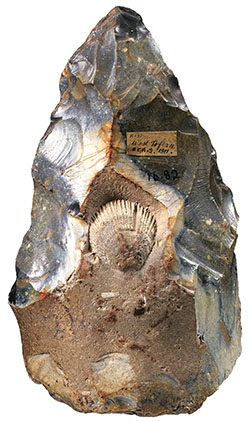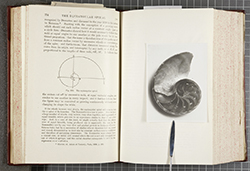MENU
The Electronic Scholarly Publishing Project: Providing access to classic scientific papers and other scholarly materials, since 1993. More About: ESP | OUR CONTENT | THIS WEBSITE | WHAT'S NEW | WHAT'S HOT
Comparative Timelines
The ESP Timeline (one of the site's most popular features) has been completely updated to allow the user to select (using the timeline controls above each column) different topics for the left and right sides of the display.
Select:
New Left Column
New Left Column
Dates
Decade
New Right Column
New Right Column
(no entry for this year)
1910
 A few years after the find of some isolated teeth from the same species, British paleontologist Clive Forster Cooper finds better specimens of what will later be identified as Paraceratherium in an area that will later be part of Pakistan. A century later, Paraceratherium will still hold the title of the biggest land mammal yet discovered.
A few years after the find of some isolated teeth from the same species, British paleontologist Clive Forster Cooper finds better specimens of what will later be identified as Paraceratherium in an area that will later be part of Pakistan. A century later, Paraceratherium will still hold the title of the biggest land mammal yet discovered.
While digging the foundation for an imposing home, two laborers, Mercer and Crittenden, discover the remains of a cremation from the Iron Age, including a Neolithic axe and a fossil echinoid.
(no entry for this year)
1911
 A chance discovery turns up the astonishingly well-preserved Clacton Spear. Made of yew and over 400,000 years old, it's one of the world's oldest wooden artifacts.
A chance discovery turns up the astonishingly well-preserved Clacton Spear. Made of yew and over 400,000 years old, it's one of the world's oldest wooden artifacts.
 A hand axe, possibly 200,000 years old and of Neanderthal design, is found in Norfolk, England. The axe has been fashioned to give prominence to a fossil bivalve.
A hand axe, possibly 200,000 years old and of Neanderthal design, is found in Norfolk, England. The axe has been fashioned to give prominence to a fossil bivalve.
Charles Dawson discovers the Piltdown skull in southern England. Excavations of faked fossils will continue for years.
(no entry for this year)
1912
Alfred Wegener proposes the theory of continental drift. His ideas will be almost completely ignored until the late 1960s.
(no entry for this year)
1913
 A. H. Sturtevant, an undergraduate working with Morgan at Columbia, provides the experimental basis for the linkage concept in Drosophila and produces the first GENETIC MAP.
A. H. Sturtevant, an undergraduate working with Morgan at Columbia, provides the experimental basis for the linkage concept in Drosophila and produces the first GENETIC MAP.
Geologist-physicist Arthur Holmes concludes that the breakdown of radioactive isotopes in igneous rocks can be used to determine when the rocks solidified. The ability to determine the absolute ages of rocks will enable scientists to better date fossils.
(no entry for this year)
1914
Charles Doolittle Walcott identifies fossil bacteria in Cryptozoon-like structures (stromatolites).
Peyrony finds the remains of Neanderthal baby in southwestern France. Because no one knows the bones are Neanderthal, they are not examined closely and are later believed lost. They will be rediscovered and described nearly 90 years later.
(no entry for this year)
1915
 Calvin Bridges identifies strains of mutant fruit flies with extra pairs of wings. Decades later, these strains will help biologists understand Hox genes that control the head-to-toe anatomy of widely varying animals.
Calvin Bridges identifies strains of mutant fruit flies with extra pairs of wings. Decades later, these strains will help biologists understand Hox genes that control the head-to-toe anatomy of widely varying animals.
 Frederick Twort discovers a virus capable of infecting and destroying bacteria.
Frederick Twort discovers a virus capable of infecting and destroying bacteria.



 Thomas Hunt Morgan, Alfred Henry Sturtevant, Calvin Blackman Bridges, and Hermann Joseph Muller publish The Mechanism of Mendelian Heredity. This monograph provides the first systematic description of the actual mechanisms that control inheritance as evidenced in the Mendelian model. Here, for the first time, the gene is made real.
Thomas Hunt Morgan, Alfred Henry Sturtevant, Calvin Blackman Bridges, and Hermann Joseph Muller publish The Mechanism of Mendelian Heredity. This monograph provides the first systematic description of the actual mechanisms that control inheritance as evidenced in the Mendelian model. Here, for the first time, the gene is made real.
(no entry for this year)
1916
Two duckbill dinosaur fossils, with extremely rare skin impressions, sink to the bottom of the Atlantic when the ship carrying them to London — the SS Mount Temple — is stopped by the German military vessel, the SMS Möwe. The German ship takes the passengers prisoner and then sinks the Mount Temple.
(no entry for this year)
1917
Stone tools discovered at Bir el Ater in eastern Algeria include triangular objects that might have been arrowheads or spear points. The tools will be dubbed Aterian, but their age will be underestimated for decades.
 British polymath D'Arcy Wentworth Thompson publishes On Growth and Form arguing that the forms Darwinian natural selection can produce through evolution are constrained by physical and mathematical laws, and that organic structures often emulate inorganic natural structures. His analysis led the way for the scientific explanation of morphogenesis, the process by which patterns and body structures are formed in plants and animals. Thompson's description of the mathematical beauty of nature and the mathematical basis of the forms of animals stimulated thinkers as diverse as Julian Huxley, Conrad Hal Waddington, Alan Turing, Claude Lévi-Strauss, Eduardo Paolozzi, Le Corbusier, and Mies van der Rohe.
British polymath D'Arcy Wentworth Thompson publishes On Growth and Form arguing that the forms Darwinian natural selection can produce through evolution are constrained by physical and mathematical laws, and that organic structures often emulate inorganic natural structures. His analysis led the way for the scientific explanation of morphogenesis, the process by which patterns and body structures are formed in plants and animals. Thompson's description of the mathematical beauty of nature and the mathematical basis of the forms of animals stimulated thinkers as diverse as Julian Huxley, Conrad Hal Waddington, Alan Turing, Claude Lévi-Strauss, Eduardo Paolozzi, Le Corbusier, and Mies van der Rohe.
 C. B. Bridges discovers the first chromosome deficiency in Drosophila.
C. B. Bridges discovers the first chromosome deficiency in Drosophila.
 Felix Hubert D'Herelle, independently of Frederick Twort, discovers a virus capable of infecting and destroying bacteria, which he calls a BACTERIOPHAGE.
Felix Hubert D'Herelle, independently of Frederick Twort, discovers a virus capable of infecting and destroying bacteria, which he calls a BACTERIOPHAGE.
(no entry for this year)
1918
First reported connection between smoking and lung cancer.
(no entry for this year)
1919
 C. B. Bridges discovers chromosomal duplications in Drosophila.
C. B. Bridges discovers chromosomal duplications in Drosophila.
 T. H. Morgan calls attention to the equality in Drosophila melanogaster between the number of linkage groups and the haploid number of chromosomes.
T. H. Morgan calls attention to the equality in Drosophila melanogaster between the number of linkage groups and the haploid number of chromosomes.
Swedish geologist Johann Andersson discovers a major "dragon bone works" in northern China. Otto Zdansky also examines the works several years later, discovering that the fossils are referred to as dragons even though the workers recognize them as more pedestrian species such as horses and deer.
ESP Quick Facts
ESP Origins
In the early 1990's, Robert Robbins was a faculty member at Johns Hopkins, where he directed the informatics core of GDB — the human gene-mapping database of the international human genome project. To share papers with colleagues around the world, he set up a small paper-sharing section on his personal web page. This small project evolved into The Electronic Scholarly Publishing Project.
ESP Support
In 1995, Robbins became the VP/IT of the Fred Hutchinson Cancer Research Center in Seattle, WA. Soon after arriving in Seattle, Robbins secured funding, through the ELSI component of the US Human Genome Project, to create the original ESP.ORG web site, with the formal goal of providing free, world-wide access to the literature of classical genetics.
ESP Rationale
Although the methods of molecular biology can seem almost magical to the uninitiated, the original techniques of classical genetics are readily appreciated by one and all: cross individuals that differ in some inherited trait, collect all of the progeny, score their attributes, and propose mechanisms to explain the patterns of inheritance observed.
ESP Goal
In reading the early works of classical genetics, one is drawn, almost inexorably, into ever more complex models, until molecular explanations begin to seem both necessary and natural. At that point, the tools for understanding genome research are at hand. Assisting readers reach this point was the original goal of The Electronic Scholarly Publishing Project.
ESP Usage
Usage of the site grew rapidly and has remained high. Faculty began to use the site for their assigned readings. Other on-line publishers, ranging from The New York Times to Nature referenced ESP materials in their own publications. Nobel laureates (e.g., Joshua Lederberg) regularly used the site and even wrote to suggest changes and improvements.
ESP Content
When the site began, no journals were making their early content available in digital format. As a result, ESP was obliged to digitize classic literature before it could be made available. For many important papers — such as Mendel's original paper or the first genetic map — ESP had to produce entirely new typeset versions of the works, if they were to be available in a high-quality format.
ESP Help
Early support from the DOE component of the Human Genome Project was critically important for getting the ESP project on a firm foundation. Since that funding ended (nearly 20 years ago), the project has been operated as a purely volunteer effort. Anyone wishing to assist in these efforts should send an email to Robbins.
ESP Plans
With the development of methods for adding typeset side notes to PDF files, the ESP project now plans to add annotated versions of some classical papers to its holdings. We also plan to add new reference and pedagogical material. We have already started providing regularly updated, comprehensive bibliographies to the ESP.ORG site.
ESP Picks from Around the Web (updated 06 MAR 2017 )
Old Science

Weird Science

Treating Disease with Fecal Transplantation
Fossils of miniature humans (hobbits) discovered in Indonesia

Dinosaur tail, complete with feathers, found preserved in amber.
Astronomy

Mysterious fast radio burst (FRB) detected in the distant universe.